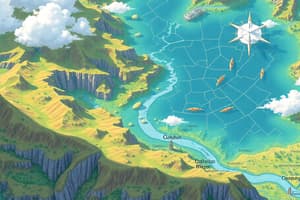Podcast
Questions and Answers
What distinguishes GIS from other information systems?
What distinguishes GIS from other information systems?
- Utilization of geospatial data in a spatial context (correct)
- Ability to program algorithms for data analysis
- Ability to store data in spreadsheets
- Incorporation of multimedia data types
What is the primary feature of the Discrete Object View in GIS?
What is the primary feature of the Discrete Object View in GIS?
- Focusing solely on numerical data without spatial reference
- Representation of data through continuous areas
- Viewing the world as consisting of fixed objects with defined boundaries (correct)
- Analyzing data without any geographical context
Which of the following is NOT a type of vector object in GIS?
Which of the following is NOT a type of vector object in GIS?
- Points
- Polygons
- Lines
- Images (correct)
Who is recognized as the 'father of GIS'?
Who is recognized as the 'father of GIS'?
There are two ways of viewing the world in GIS. What are the two ways and define them
There are two ways of viewing the world in GIS. What are the two ways and define them
Which is not an example of discrete object view
Which is not an example of discrete object view
Adjacency- share common boundary
Adjacency- share common boundary
Which option best describes the primary function of GIS?
Which option best describes the primary function of GIS?
Which of the following best identifies the representation of real-world items in a Discrete Object View?
Which of the following best identifies the representation of real-world items in a Discrete Object View?
Which of the following statements about vector objects is accurate?
Which of the following statements about vector objects is accurate?
In the context of GIS, how are polygons defined?
In the context of GIS, how are polygons defined?
What distinguishes the GIS vector data model from other data models?
What distinguishes the GIS vector data model from other data models?
Flashcards are hidden until you start studying
Study Notes
What Makes GIS Unique?
- GIS connects non-spatial data to locations, creating a unique opportunity to analyze data geographically
- Unlike spreadsheets, GIS allows you to explore data in a spatial context, offering visual insight and analysis
GIS and Data Visualization
- GIS can handle various geospatial information, including capturing, creating, manipulating, storing, and visualizing data
- Robert Tomlinson is credited as the pioneer of GIS, recognizing his contributions to the field
Understanding the World with GIS
- GIS employs two common approaches to simplify and analyze real-world information:
- Discrete Object View: Views the world as a collection of distinct objects with defined boundaries and locations, such as buildings, roads, and crimes.
Vector Data Model: Representing Reality
- Vector data model utilizes points, lines, and polygons to represent real-world objects within the GIS environment:
- Points: Represent 3D locations
- Lines: Define 1D paths with defined starting and ending points
- Polygons: Represent areas defined by connected lines (e.g., a city boundary)
Creating Vector Data
- Vector objects are generated using "digitizing," which involves tracing or sketching real-world features from maps or images, translating them into digital representations within the GIS.
GIS
- GIS are a type of information system that allows users to tie non-spatial data to a location or use the information to create a map.
- GIS separates itself from other information systems by the ability to explicitly utilize geospatial data.
- Robert Tomlinson is considered the "father of GIS".
- GIS can analyze, capture, create, manipulate, store, or visualize all manner of geospatial information.
Discrete Object View
- This is a method of simplifying real-world information when viewing the world as a series of objects.
- Each object in the Discrete Object View has a fixed location, fixed starting/stopping points, or a fixed boundary.
- Each object is represented by points, lines, or polygons.
- Points: 3-dimensional set of coordinate locations
- Lines: 1-dimensional with starting and ending points
- Polygons: 2-dimensional objects that form area from a set of lines
- Points, lines, and polygons are referred to as vector objects.
- Vector objects form the basis of the GIS vector data model.
- Vector objects can be created through digitizing, through sketching or tracing representations from a map or image source.
Studying That Suits You
Use AI to generate personalized quizzes and flashcards to suit your learning preferences.




